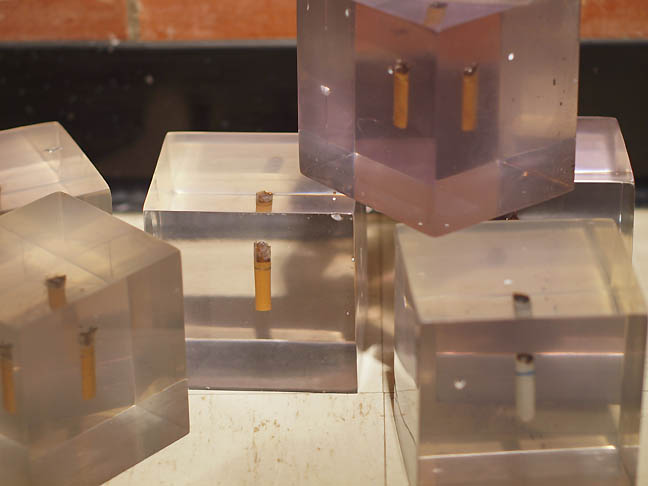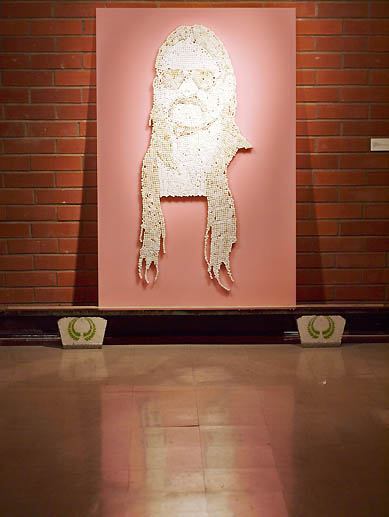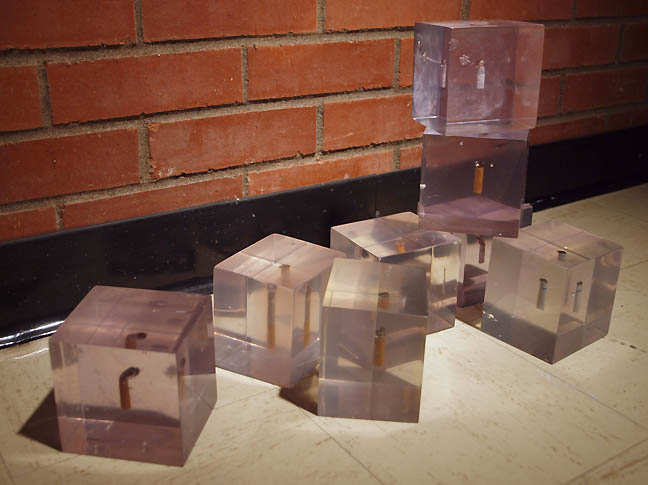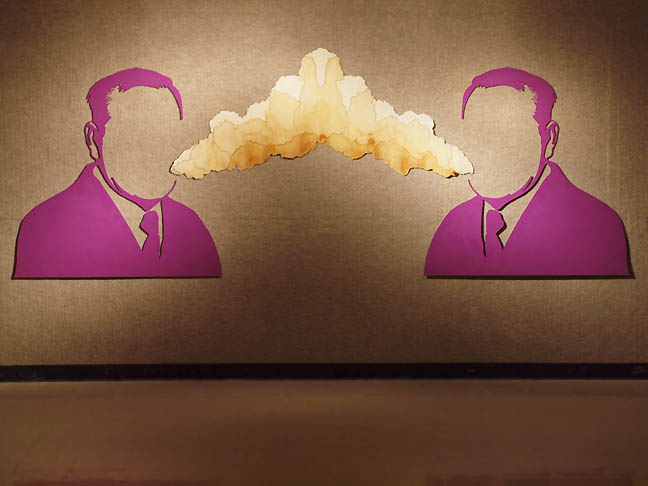
|
||
|
Portland art blog + news + exhibition reviews + galleries + contemporary northwest art
|
||
Sean Healy's Smudge at Pacific University  Sean Healy's Half a Pack a Day Man (detail) It has been over 2 years since Oregon has been treated to a Sean Healy exhibition and Smudge, by virtue of the fact that it is a non-commercial show is perhaps the artist's most satisfying effort to date. With its smart graphic and material sensibilities that owe a bit to Ed Ruscha and Richard Prince, Smudge, is an object ode... supposedly to the vice and sense of invulnerability that youth enjoys. Sited on a very nice university campus this subject matter seems perfectly tuned to the context. Specifically, Pacific University's Cawein gallery in Forest Grove seems incredibly far removed from Portland's encampment of urban hipsters, which the work seems to allude to. It also feels like a modernist sylvan oasis and since the gallery THANKFULLY isn't a generic white box its grey fabric walls, linoleum floors and red brick feel like a secret institutional rat pack era clubhouse. One could read the room as a teachers lounge or an AV club room but by virtue of being a gallery Smudge's gritty ingredient list of cigarette butts, ash and beer creates an intense feeling of failed bohemian lifestyles stewing in their own ennui.  Pissholes in the Snow The first piece one notices is Pissholes in the Snow. The aviator glasses on the middle aged adult seems to say, "yeah you really showed society with your nonconformism, Dude." It's a funny piece that is perhaps a little too in on its own joke to be more than good and had Healy done an entire show of these it would have doomed the show to feeling like the weekly cover of the Mercury. Yet alone, with the red brick/linoleum background also makes me feel like this could be a janitor or teacher's portrait when off duty during the summer as they put the shades on and dig their motorcycle out of the garage. Not lame but somehow lower than one's youthful expectations. It is a theme common to most Americans born after the Baby Boomers, we feel like we wont have it as good as our parents had it. 
Half a Pack a Day Man It is followed by the most successful piece in the show, Half a Pack a Day Man. Here Healy embeds the gritty cigarette butts in acrylic cubes and manly poignancy. By turning addiction of the supposedly low level variety into objects that can be arranged and stacked like a child’s blocks he's made the existential self-loathing and pride a little more present. By turning garbage into art worth thousands of dollars Healy might be foregrounding the casual time and effort spent smoking as the most valuable element of the work? This is a powerful idea and the repulsive grit of the butts combined with the pleasant light purple transparency of the cubes has a nice push/pull that successful art embodies. It also keeps the question of manliness as addiction in the viewer's mind? I've never been interested in smoking but I wonder how these would operate as art for a viewer who had kicked the habit? Would they feel like trophies or reminders of a battle they fight? 
Beer Breath The largest work in the show, Beer Breath, presents a mirror imaged pair of faceless suited businessmen spewing beer vapor at each other. To me it feels like a cheeky riposte to frat boy beer parties... is it a post college kegger middle age denouement? It is funny and puts Healy's strong graphic sensibilities on display but it also could be read as having a hint of anger at Wall Street fanciers who seem to contest each other in the markets? Is their self-serving competitive spirit a detriment of those who are not playing their game of fee generation.... one where the real value of something matters less than the perceived movement up or down in the market. Or maybe I'm just an art guy who never liked keggers and their cheap beer? The final works in the show, Smudge I and II, are rectangles comprised of unsmoked cigarette filters. I don’t find them very convincing but they do make an interesting corollary to the ritualized perseverance in Agnes Martin’s works. They aren't likely supposed to be all that convincing with a title like Smudge but they do round out the excess and redundancy of smoking that forms the backbone of the exhibition. In short they round out the gestalt with a poignant sense of resignation and stagnation, staying true to the theme. It seems to ask, "What happens when youth fades, what remained meaningful?" As an exhibition Smudge succeeds far more than the individual works, a complete reversal of every solo show I've seen of his in Portland's city limits to date. As a venue this excellent and idiomatic space holds tremendous potential to artists who want to do something non-commercial and conceptually focused. Smudge runs through November 26 Posted by Jeff Jahn on November 14, 2013 at 13:36 | Comments (0) Comments Post a comment Thanks for signing in, . Now you can comment. (sign out)
(If you haven't left a comment here before, you may need to be approved by
the site owner before your comment will appear. Until then, it won't appear
on the entry. Thanks for waiting.)
|
| s p o n s o r s |
 |
 |
 |
 |
 |
 |
 |
 |
 |
 |
 |
 |
 |
 |
 |
 |

|
Site Design: Jennifer Armbrust | • | Site Development: Philippe Blanc & Katherine Bovee | |

